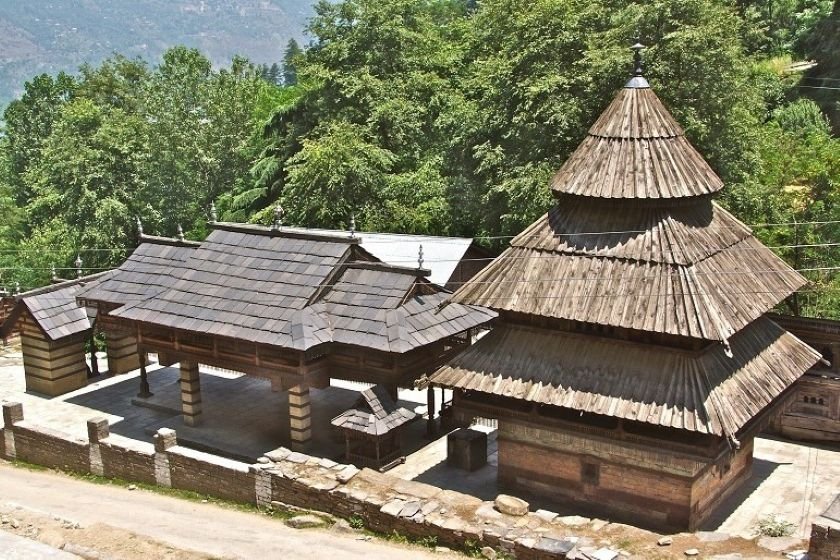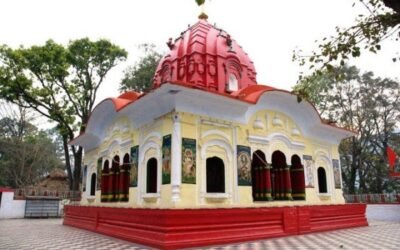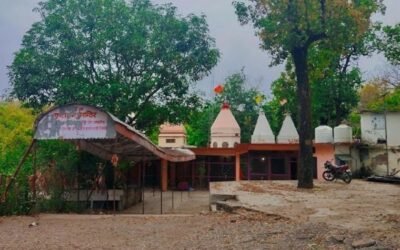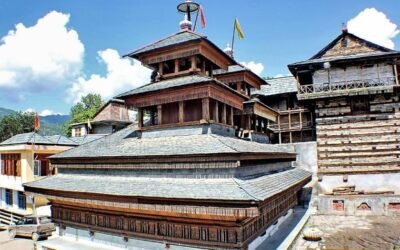Where the Supreme Devi weaves her presence into wood, stone, and sky
Perched on a forested ridge above the Beas River in the ancient town of Naggar, the Tripura Sundari Temple is a sacred jewel of the Kullu Valley. Dedicated to Goddess Tripura Sundari, the Supreme Devi and embodiment of Shakti, this temple is revered as the Ishta Devi (tutelary goddess) of the region. With its pagoda-style architecture, mythic origins, and panoramic views, the temple is a spiritual and architectural marvel that echoes with centuries of devotion.
🌄 Location & Accessibility
- Location: Near Naggar Bus Stand, Naggar, Kullu District, Himachal Pradesh – 175130
- Altitude: ~1,800 meters
- By Road: 21 km from Manali, 23 km from Kullu; taxis and buses available
- By Air: Bhuntar Airport (~35 km)
- By Rail: Joginder Nagar (~125 km) or Pathankot (~270 km)
- On Foot: A short uphill walk from Naggar Castle through pine-shaded paths
🕉️ Deity & Worship
The temple is dedicated to Goddess Tripura Sundari, a form of Durga and the Supreme Mother Goddess in Shakta tradition. She is worshipped here as the protector of the valley, and her presence is believed to sanctify the land and its people.
The goddess is worshipped in the form of three pindis, representing Maha Kali, Maha Lakshmi, and Maha Saraswati.
Devotees offer red flags, coconuts, and sweets, and the temple is especially known for fulfilling wishes of childless couples and those seeking justice. Rituals include offering incense, ghee lamps, and seasonal flowers, along with recitation of Devi Suktam and Durga Stotra. The temple also houses stone idols of Brahma, Vishnu, Shiva, Lakshmi, Parvati, and Ganesha, reflecting its pan-Hindu sanctity.
🏛️ Architecture & Setting
Built in the 16th century by Raja Yashodhapal, the temple is a three-tiered pagoda structure made of deodar wood and stone, inspired by the Hadimba Devi Temple in Manali. According to legend, the goddess herself took the form of a spider and spun the temple into existence, which is why the structure resembles a web.
Key features include:
- Intricately carved wooden panels depicting deities, floral motifs, and mythic scenes
- A circular pinnacle crowned by a chhatra (umbrella) symbolizing divine sovereignty
- A small idol of Tripura Rakshasa (demon), symbolizing the goddess’s victory over evil
- A stone-paved courtyard surrounded by cedar trees and prayer flags
The temple’s elevated location offers breathtaking views of the Kullu Valley, making it a place where spirituality meets Himalayan grandeur.
📜 Mythological Significance
In local lore, Tripura Devi is said to have chosen Naggar as her abode, and the village itself was settled at her divine will. She is believed to travel across the valley in a palanquin during seasonal festivals, accompanied by golden mohras (sacred masks) and traditional musicians.
The temple is considered a Shakti Peetha of the Western Himalayas, and her blessings are invoked for protection, fertility, and cosmic balance. The web-like design of the temple is seen as a metaphor for the interconnectedness of all life, woven by the goddess herself.
🎉 Festivals & Celebrations
- Sharhi Jatra (May): A vibrant fair held in honor of the goddess, featuring folk dances, music, and ceremonial processions
- Navratri: Special pujas, community feasts, and devotional singing mark the nine nights of the goddess
- Daily Worship: Includes morning and evening aartis, offering of red cloth, and chanting of Shakta hymns
🏞️ Nearby Attractions
- Naggar Castle: A historic wooden fortress with panoramic views and a museum
- Gauri Shankar Temple: An ancient Shiva shrine with exquisite stone carvings
- Nicholas Roerich Art Gallery: Home of the Russian painter and mystic who fell in love with the Himalayas
- Jana Waterfall & Arjun Gufa: Scenic spots steeped in local legend and natural beauty
🙏 Spiritual Experience
The Tripura Sundari Temple is not just a shrine—it is a woven prayer in wood and wind, a place where the goddess’s grace flows through every carved beam and cedar breeze. As you stand before her sanctum, with the valley unfolding below and the sky above, you feel the threads of destiny, devotion, and divine presence gently pulling you inward. It is a temple where Shakti breathes, and the soul remembers its source.




